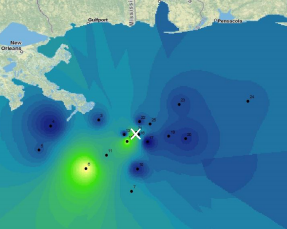
This map shows the radiocarbon content of sediments on the seafloor of the Gulf. The more bright colors represent less radiocarbon; indicative of oil input. You can clearly see the trace of the oil plume to the southwest of the spill site (marked with an x). Image credit: Jeff Chanton, FSU
The effects of the Deepwater Horizon oil spill on the ecology of the Gulf of Mexico are, for the most part, still unknown. Florida State University has developed an integrated study of the impact of oil on the coastal and ocean marine ecosystem of the Gulf of Mexico, including the northern West Florida Shelf, extending from the Big Bend Region west to Louisiana. They are investigating the effects of the spill on coastal ecosystems with a particular emphasis on changes in the food webs that support major commercial and recreational fisheries in the Gulf and in locating oil on the seafloor.
Classroom Activity: You Are What You Eat
Students will investigate a food chain and explore how what an animal eats and where it lives leaves permanent chemical marks on them. The chemical marks can be analyzed by scientists and allow them to learn about the animals life history.
Florida to Louisiana_Tracing the Oil – PDF 1.2MB
